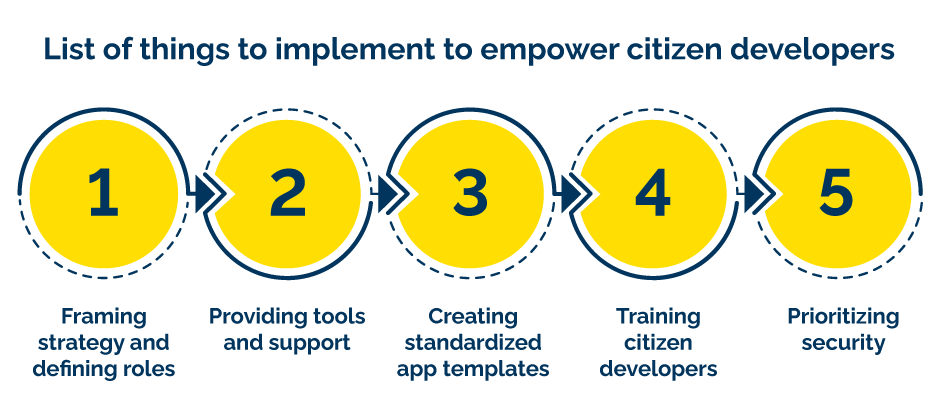
This article (The Yoda way to knock IT backlogs out of the park!) was first published on Customer Think.
The problem of growing IT backlog is not new, however, the strengthening of the bond between business users and shadow IT has become a cause of concern for sure. With companies rushing to embrace digital transformation, this problem is growing rapidly like a forest fire, threatening to obliterate data privacy totally if no actions are taken to address it.
Fortunately enough, the IT pros have a solution to put out that fire and wipe out IT backlogs. The solution is to empower citizen developers with IT governance.
Citizen developers are pseudo-programmers who, though not professional developers, build applications using No-code/Low code platforms to empower business processes. According to a survey report by Gartner, 41% of respondents have active citizen development initiatives, and 20% of those that don’t are either evaluating or plan to start these initiatives.
Also read: How to Implement and Govern Citizen Development in your Organization
However, Citizen development comes along with its own set of problems. These problems include redundant development, substandard quality apps, and a tangled mess of unsanctioned networks.
For instance, two citizen developers of different departments building a similar app for task management leads to superfluity, as a result. Therefore, business houses must implement effective monitoring in order to solve such issues, which is where IT governance comes into play.
Without governance, business users are more likely to select inefficient IT solutions which might result in the loss of sensitive organizational data.
5 Things to Implement to Empower Citizen Developers
Establishing IT governance over citizen developers can be a daunting task but fret not! We have got you covered. Here’s a list of things to implement that can empower your citizen developers:

1. Framing strategy and defining roles
The first thing to take into consideration before implementing citizen development is having goals defined. Here’s a list of questions that a CIO must have answers to before implementing this initiative. Having a clear objective of what is expected out of citizen developers, what is the company’s vision of implementing citizen development, and what type of apps to be built is vital to successful implementation.
Additionally, contemplating who will be the citizen developer and also enumerating the required number of developers in each department is the right way to set the foundation for citizen development.
2. Providing tools and support
IT pros are master programmers whereas citizen developers have nothing to do with programming, hence digital leaders must find a common ground for these two extremes. Here, platforms such as no-code and low code development can be a perfect solution. With No-code app development platforms, business users can build apps that solve their problems and IT can support and improve their technique in addition to overseeing the development activities.
There are numerous No-code, Low-code platforms available in the market, choosing the one that makes the process easy and allows IT to focus on bigger digital transformation projects is vital. Here’s a list of points you can consider that can help you select the most effective platform for your organization.

3. Creating standardized app templates
The most major concern associated with citizen developers is redundant development, which wastes time and effort. The No-code and Low-code app platforms, on the other hand, come with standardized app templates that can assist save time; users can either utilize the templates as is or modify them to suit their needs. Also, for freshly generated apps, a standardized app templates repository might be beneficial because business users don’t have to start from scratch; instead, they can choose from existing templates that meet their needs.
The key to do that is building close collaboration between business users and IT professionals, as well as establishing accountability so that when a significant app is created, IT is aware of it and can make it available to others.
4. Training citizen developers
IT governance necessitates the training of citizen developers because without training implementing citizen development will only prove a burden on the IT department. A highly trained citizen developer may create apps and quickly address problems without bothering IT, hence minimizing IT backlogs.
Initially, citizen developer training should be strictly instructional, with key information about the tool, basic concepts, and expectations provided. Following that, developers should be given ongoing training so that they can continue to offer high-value apps to enhance business processes.
5. Prioritizing security
The problem of business users relying on unsanctioned IT solutions for the purpose of clearing IT backlogs poses a serious threat of loss of critical data. However, this problem can be solved with strong monitoring and control.
To keep the problem of data security in check, business leaders need to lay out specific guidelines and rules. Also, a clear path should be defined with definite checkpoints to monitor and control all the development activities.
Also read: The Rise of the Citizen Developer and why should every business care?
The Takeaway
All organizations have citizen developers, any employee using the SaaS tools to make his work life easy is a citizen developer too. However, governing citizen development and providing effective tools to business users is the real deal.
You can either choose to leave the situation as it is and let shadow IT takeover or you can play it right by linking IT governance with citizen developers and let them speed up the internal functioning of the organization, the choice is yours! Find out where your organization stands in the world of citizen development. Assess your maturity now!
Login
Please login to comment
0 Comments
Oldest















